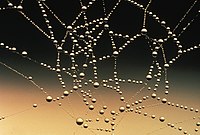Condensation: Difference between revisions
m Reworded sentance |
No edit summary |
||
| Line 3: | Line 3: | ||
'''Condensation''' is the change in matter of a substance to a denser phase, such as a [[gas]] (or vapor) to a [[liquid]]. Condensation commonly occurs when a vapor is cooled to a liquid, but can also occur if a vapor is compressed (i.e., [[pressure]] on it increased) into a liquid, or undergoes a combination of cooling and compression. Liquid which has been condensed from a vapor is called '''condensate'''. A device or unit used to condense vapors into liquid is called a '''[[condenser]]'''. Condensers are typically coolers or [[heat exchanger]]s which are used for various purposes, have various designs, and come in many sizes ranging from rather small (hand-held) to very large. |
'''Condensation''' is the change in matter of a substance to a denser phase, such as a [[gas]] (or vapor) to a [[liquid]]. Condensation commonly occurs when a vapor is cooled to a liquid, but can also occur if a vapor is compressed (i.e., [[pressure]] on it increased) into a liquid, or undergoes a combination of cooling and compression. Liquid which has been condensed from a vapor is called '''condensate'''. A device or unit used to condense vapors into liquid is called a '''[[condenser]]'''. Condensers are typically coolers or [[heat exchanger]]s which are used for various purposes, have various designs, and come in many sizes ranging from rather small (hand-held) to very large. |
||
Condensation of vapor into liquid is the opposite of [[evaporation]] or [[boiling]] and is an [[exothermic]] process, meaning it releases heat. |
Condensation of vapor into liquid is the opposite of [[evaporation]] or [[boiling]] and is an [[exothermic]] process, meaning it releases heat. The water seen on the outside of a cold glass on a hot day is condensation. |
||
==Condensation of water in nature== |
==Condensation of water in nature== |
||
Revision as of 03:53, 29 June 2006
- For other uses of the term, see Condensation (disambiguation)

Condensation is the change in matter of a substance to a denser phase, such as a gas (or vapor) to a liquid. Condensation commonly occurs when a vapor is cooled to a liquid, but can also occur if a vapor is compressed (i.e., pressure on it increased) into a liquid, or undergoes a combination of cooling and compression. Liquid which has been condensed from a vapor is called condensate. A device or unit used to condense vapors into liquid is called a condenser. Condensers are typically coolers or heat exchangers which are used for various purposes, have various designs, and come in many sizes ranging from rather small (hand-held) to very large.
Condensation of vapor into liquid is the opposite of evaporation or boiling and is an exothermic process, meaning it releases heat. The water seen on the outside of a cold glass on a hot day is condensation.
Condensation of water in nature
Water vapour will only condense onto another surface when that surface is cooler than the temperature of the water vapor, or when the water vapor equilibrium in air, i. e. saturation humidity, has been exceeded. When water vapor condenses onto a surface, a net warming occurs on that surface. The water molecule brings a parcel of heat with it. In turn, the temperature of the atmosphere drops very slightly. In the atmosphere, condensation of water vapour is what produces clouds. The dew point of an air parcel is the temperature to which it must cool before condensation in the air begins to form.
Also, a net condensation of water vapor occurs on surfaces when the temperature of the surface is at or below the dew point temperature of the atmosphere. Deposition is a type of condensation. Frost and snow are examples of deposition (or sublimation). Deposition is the direct formation of ice from water vapor.

